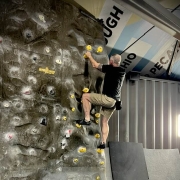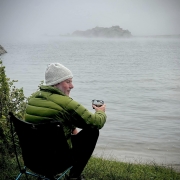How to be a Super Ager | Healthy Aging Series: S10 E21
My Parents Loved Books
My mother taught me to love books. She was reading all the time. The first book she gave me was a copy of Mila 18 by Leon Uris. I was a Junior in High School, and I would sit in the back of Government Class and read it during class. Sorry Mr. Chambers.
When my parents were aging, we would visit them and would see books stacked everywhere in their home. Mostly books on religion. It was never a problem deciding what to get mom or dad as birthday gifts.
I love books. Not like I love my wife, or my sons, but I love books. My office is full of books. They are a reflection of me in the same way that my clothes reflect me. I have theological books that reflect my three theological degrees. I have clinical books. Books on Analytical Psychology and Carl Jung that reflect that part of my journey. I have fitness books that reflect my life in my late 50s. I wanted to be fit. There are books in my office on hiking trails. I have close to 100 books that reflect where I’ve been and where I want to go.
The Aging Brain
This season is on the aging brain and ways to take care of your brain. Have you noticed that there are older people that seem to defy aging?
You’ve probably heard of the term “Active Agers.” It’s used to describe people in their 60s, 70s, and 80s, that well, stay active. You see them in the malls walking in their Hokas. Some are part of a group called Silver Sneakers. I ran into some Active Agers in the Jefferson Forest with their day packs and they’re trekking poles. I love seeing older hikers, because I’m an older hiker.
Super Agers
There’s a new term that I see more often to describe Active Agers and it’s the term Super Ager. A Super Ager is someone in their late 70s or 80s that has the cognitive fitness of someone in their 40s or 50s. There aren’t a lot of Super Agers. Generally speaking, they aren’t just mentally fit, but also physically fit. That makes sense. Healthy body, healthy brain equals mental fitness. There is bad news about the aging brain. The older you get, the smaller your brain gets. Here’s the good news: researchers have discovered that Super Agers have larger brains. So, can anyone become a Super Ager? Wouldn’t you like to be a Super Ager; someone who is 80 or 90 with the mental and cognitive fitness of a 40 or 50-year-old? How does a person avoid shrinkage? You know, brain shrinkage?
How to Become a Super Ager
The Three Things You Can do to be a Super Ager
Exercise. What kind of exercise should you be doing? Every kind! Move! There is a lot of research that recommends moderate-level cardio exercise. Your exercise does not have to be extreme. Getting your heart rate up over 100 is very important. I’m sure you’ve heard of HITT exercises (High Intensity Interval Training). Doing high intensity exercises are beneficial but not necessary. You can do MITT exercises (Moderate Intensity Interval Training). Think hills. The reason you lose muscle is mostly because you quit using your muscles. Yes, there are other issues like a decrease in testosterone and nutritional issues, like the decrease in intake of protein. But by and large, older adults lose muscle because of inactivity. It’s called Sarcopenia. I’m going to write about that next season when I do a season on the aging body.
BDNF is your BFF. I originally wanted to call this episode “BDNF is your BFF.” What is BDNF? Its Brain Derived Neurotrophic Factor. It’s a protein growth factor that plays a crucial role in brain development and neuroplasticity. It’s essential for learning and memory. Infants have very high levels of BDNF, which makes sense because their brains are growing exponentially in those early years. As we age, it’s important to preserve brain integrity and brain fitness. There are lots of things that we can do to increase the production of BDNF and one of the simplest ways of doing this is… drumroll… exercising. Nutrition obviously plays a role, but exercise promotes the increase of BDNF which promotes brain growth.
Nutrition. There is no doubt that increasing polyphenols like blueberries as well as increasing your omega-3 oils found in fish oils and avocados, and following the MIND Diet, which I described in an earlier episode. If you want to increase the BDNF in your brain, then eat lots of fruits and vegetables. Eat real food.
Mental Exercise and Cognitive Reserve. I’m also convinced that if you are mentally active and exercise your brain, you can prevent the loss of brain volume, which will maintain what some call Cognitive Reserve. What is Cognitive Reserve? Think, extended life battery. Super Agers have extended life batteries. If you want to be a Super Ager, make BDNF your BFF. Use it or lose it.
Super Agers have bigger brains because Super Agers use their brains a lot.
What kind of mental exercises promote cognitive reserve? Let me suggest three ways to train your brain. I have gathered this information from the Harvard Medical School Special Health Report, “A Guide to Cognitive Fitness.” I highly recommend these special health reports.
“Ideally you want to start stockpiling cognitive reserve in your youth,” they write, “and continue the process throughout your lifetime. Almost everything you do can become mental exercise if you pay attention to it and try to get better at it. Three guiding principles, the cardinal rules of mental stimulation will help you achieve this.”
First, try something new. Continually expand your horizons by trying new experiences that fall outside your comfort zone. Things like a painting class, learning a new skill such as gardening, a new language or a musical instrument.
Second, challenge yourself. If you have a favorite activity, continue to increase the level of difficulty of that activity. This will build cognitive reserve.
Your cognitive workout should be progressively more difficult the way that your Personal Trainer works with you in the gym. You start with the easy stuff like body-weight exercises and progressively move to light weights, then the heavy stuff.
Third, keep introducing new activities to maximize your mental workouts. I love their suggestion of travel. Visiting a new place can yield lots of rewards this manual suggests.
You have the chance to interact with new people, gain new experiences, and visit sites you’ve previously seen only in books or on television. This health report also suggest trying new puzzles, learning a new language, trying new card games and boardgames, watching plays, films, concerts, and going to museums. I am regularly seeking out new types of music.
If you want to be a Super Ager, you have to work at it.
People don’t become Super Agers by accident. They developed a lifestyle that promotes cognitive reserves, which in turn, produces brain growth.
Schedule learning opportunities for yourself every week. Try to avoid those very passive learning experiences like phone-scrolling or watching television. Those aren’t horrible things to do. They just don’t improve your cognitive reserve in the same way that mental exercise does.
I have mentioned many times throughout my writing and in my practice that you have to prepare for the last 10 years of your life. Being a Super Ager is just one way of doing that.




